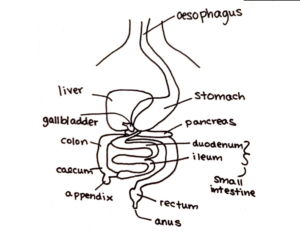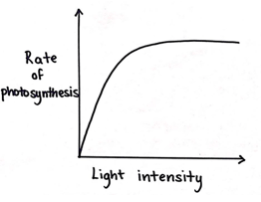|
Nutrition |
|
|
Autotrophic: makes own food |
Heterotrophic: takes in food |
|
Photosynthesis: uses light energy. |
Herbivore: eats plants. |
|
Chemosynthesis: uses chemical energy |
Carnivores: eats animals. |
|
Omnivores: eats plants & animals. |
|
Digestion is the breakdown of food from large insoluble molecules into smaller soluble molecules.
- Digestion is necessary because the food we eat is made of complex molecules that are too big for us to absorb directly. They need to be broken down into simpler, smaller, soluble molecules in order for us to absorb them.
- A digestive system is necessary because it allows for more efficient breakdown of food, hence more energy and a greater ability to survive. Many specialised enzymes are necessary for digestion of food. If every cell in the body had to produce these enzymes in order to digest food, it would be energy and time consuming. That’s why it is better to have a specific digestive system that contains these enzymes and have all the food in the body broken down there.
Stages in Nutrition:
- Ingestion: Food is taken into the digestive system
- Digestion: Food is broken down
- Physically/Mechanically: The crushing and grinding of food
- Chemically: Food is broken down by acid and enzymes
- Absorption: Digested food is taken into the bloodstream. Most water is absorbed in the colon.
- Egestion: Unabsorbed material is removed from the body
Think of the digestive system as a long tube that goes through the body, starting at the mouth and ending at the anus. This is called the alimentary canal. (Alimentary means “relating to food”)
The Digestive System
Basic overview of the alimentary canal
- Food enters the alimentary canal at the mouth, where it is physically digested by the teeth and chemically digested by enzymes
- The food (now a bolus) is swallowed into the oesophagus. It moves down the oesophagus by peristalsis.
- The bolus enters the stomach, where is it physically churned. Hydrochloric acid kills microbes. The bolus is further digested by enzymes.
- The bolus passes into the small intestine – first the duodenum (main site of digestion) and then the ileum (main site of absorption).
- In the duodenum, the bolus encounters enzymes from the pancreas (which enter the duodenum via the pancreatic duct). It also encounters bile from the gallbladder.
- In the ileum, biomolecules such as glucose and proteins enter the portal system and are brought to the liver.
- Fats that have been digested are absorbed into the lymphatic system in the ileum.
- The parts of the bolus that are not absorbed in the ileum pass into the large intestine.
- Water is absorbed in the colon.
- The remained of the unabsorbed bolus is pushed along the colon by peristalsis and becomes faeces.
- Faeces are stored in the rectum and egested by the anus.

Mechanical digestion of food occurs due to:
- Teeth (tear, grind and crush food)
- Peristalsis
- Peristalsis: The alternate contraction and relaxation of the wall of the alimentary canal, that moves food down the canal. Fibre stimulates peristalsis.
- Stomach contractions (physically churn food)
Chemical digestion of food occurs due to:
- Bile salts (produced in the liver but stored in the gallbladder).
- Enzymes – amylases (break down carbohydrates), proteases (break down proteins) and lipases (break down fats)
Mouth:
Teeth:
- Incisors: Bite/slice food
- Canines: Grip and tear food
- Pre-molars and molars: Chew/grind food
- Dental formula: I2/2 C1/1 P2/2 M3/3
- Chemical digestion also occurs as enzyme salivary amylase digests starch to maltose.
- Alkaline environment.
- Saliva contains lysozyme that kills microorganisms.
Oesophagus (eez-AW-fah-gus):
- This is a muscular pipe.
- Moves food down the body by peristalsis.
- There is a sphincter between the oesophagus and the stomach. A sphincter is a collection of muscle fibres that encircle a tube to stop movement (think of it like a hair bobbin). This is known as the cardiac sphincter (nothing to do with the heart as such. The name simply means that it is located closer to the heart than sphincter at the far side of the stomach, known as the pyloric sphincter).
The stomach:
- The stomach stores and digests food using both mechanical and chemical means.
- It is a muscular bag, which churns food to make chyme.
- The stomach lining makes:
- Mucous
- Prevents the stomach wall from acid and enzymes
- Pepsinogen
- It becomes its active form, pepsin, in an acidic environment.
- Pepsin is a protease enzyme, meaning it breaks down proteins. Proteins that enter the stomach are broken down into shorter polypeptides.
- The purpose of this 2-step activation is to prevent the stomach digesting itself (think about the stomach wall: it is made of protein)
- the activated enzyme breaks down protein to peptides
- Hydrochloric acid (HCl)
- Kills bacteria
- Softens food
- Denatures amylase (that comes in from the salivary glands of the mouth and functions best in an alkaline environment)
- Mucous
- Peptic ulcers (“stomach ulcers”) develop when the protective mechanisms fail or, more commonly, due to a bacterial infection with Helicobacter pylori. This presents with symptoms of pain, heartburn and nausea. Treatments: antibiotics. If the ulcer isn’t treated, it can eat through the entire stomach wall, or “perforate”. This is a life-threatening emergency treated surgically.
The duodenum:
- Main location for digestion.
- Contains a range of digestive enzymes – pancreatic amylase, lipase and protease (see pancreatic section).
- These enzymes are delivered to the duodenum from the pancreas via the pancreatic duct.
- Receives bile from the gall bladder via the bile duct. Bile neutralises the acidic chyme and emulsifies lipids to lipid droplets (increases surface area for lipase enzymes to work).
- Alkaline environment
The ileum:
- Absorbs food (by this point the enzymes and the food have had a chance to mix, so the food has been broken down into the basic building blocks that can be absorbed into the blood). The walls of the small intestine are one cell thick to aid this.
- Lined with many villi (finger-like outgrowths, villi = plural, villus = single) to increase surface area. Each villus is covered in microvilli.
- It has a generous blood supply with extensive capillary networks (this allows quicker absorption). Each villus has a “lacteal” inside it, which drains into the lymphatic system and carries away the digested fats.
- Glucose and amino acid are absorbed into the bloodstream and taken into the liver via the portal vein.
- Fatty acids and glycerol enter the lacteals and are transported in lymph and returned to the bloodstream for distribution around the body.
The pancreas:
- Makes sodium hydrogen carbonate to neutralise acid from the stomach.
- Enzymes such as amylase (breaks down starch to maltose) and lipase (breaks down fats to fatty acids and glycerol) and proteases (breaks down proteins to amino acids)
- Has an important endocrine function (insulin, glucagon)
The liver:
- Makes bile which is alkaline and emulsifies fat to aid digestion. Bilirubin and biliverdin (breakdown products of old red blood cells) and excess cholesterol are excreted with bile. Bile is stored in the gallbladder.
- Makes sodium hydrogen carbonate to neutralise acid.
- Stores many fat-soluble vitamins (A, D, E, K), glycogen and minerals
- Important in maintaining the temperature of the blood passing through it
- Receives blood from the intestines via the portal system – the hepatic portal vein. The intestines are different to all other organs: the venous blood from the intestines doesn’t drain straight to the heart. It drains to the liver first. Why? The nutrients/chemicals/toxins/drugs that we ingest end up being absorbed into our blood. The liver is a metabolic sorting station that deals with all of this input, detoxifies and maintains homeostasis. The hepatic vein then transports nutrients and urea from liver to heart. These are transported away from the heart via the aorta. Urea is transported to the kidneys.
- Forms cholesterol
- Deamination (breakdown of amino acids with the production of urea)
- Makes fibrinogen (a clotting protein)
The colon:
- The large intestine is actually shorter than the small intestine. Its diameter is much bigger, which is why it is called the large intestine.
- The colon reabsorbs water from waste, forming faeces. If not given enough time to reabsorb, this results it diarrhoea. The opposite is constipation and it results in hard stools.
- There are symbiotic bacteria in the colon. They have many functions, including making vitamin K, digesting cellulose and preventing harmful microorganisms from growing.
- The caecum is a part of the colon that has the appendix. It is located in the right lower part of the abdomen. The appendix is a worm-like projection that doesn’t serve any significant function today (a “vestigial” organ). If a piece of food or faeces gets lodged in the appendix, it becomes inflamed. This is called appendicitis. This presents with pain, nausea, vomiting, fever. Appendicitis is treated with antibiotics and surgical removal of the appendix.
- The rectum stores faeces.
- Faeces exit the body via the anus
Components of a balanced diet:
- Carbohydrates
- Proteins
- Fats
- Vitamins
- Minerals
- Water
- Fibre (stimulates peristalsis (prevents constipation), soaks up toxic chemicals and cholesterol as it travels through the gut unabsorbed, it may prevent colon cancer)
BMI and eating disorders
The amount of food a person requires depends on age, activity, gender and health.
BMI = body weight in kg/ (height in m)2
Being overweight (BMI above 25) or obese (BMI over 30) is associated with heart disease, stroke, diabetes and arthritis.
Anorexia nervosa is an eating disorder. [You don’t need all this detail for the exam, but people always seem to like to know this.] Symptoms include persistent restriction of energy intake leading to significantly low body weight, an intense fear of gaining weight or of becoming fat, or disturbance in the way one’s body weight or shape is experienced, undue influence of body shape and weight on self-evaluation, or persistent lack of recognition of the seriousness of the current low body weight. It can cause lack of periods, cardiac problems and life-threatening electrolyte imbalances. It is treated with psychiatric input: counselling and medication, as well as medical input for physical problems (e.g. osteoporosis, infertility, etc).
Bulimia is also an eating disorder. It involves recurrent episodes of binge eating characterised by eating for an amount of time (within a 2 hour period) large amounts of food and a sense of lack of control over eating during an episode. It is followed by inappropriate compensatory behaviour in order to prevent weight gain (purging).
Four food groups (recommended servings per day):
- Cereals, breads, potatoes (6+)
- Fruit and vegetables (4+)
- Milk, cheese and yoghurt (4)
- Meat, fish and poultry (2)
Summary of enzymes
- Amylase:
- Produced in salivary glands as well as pancreas
- Acts in the mouth and duodenum
- Breaks down starch to maltose
- pH 7-9
- Pepsin:
- Pepsinogen produced by stomach lining
- Activated by acid into its active form
- Acts in stomach
- Breaks down protein to peptides and amino acids
- pH 2
- Lipase:
- Produced in pancreas
- Acts in duodenum
- Breaks down lipids to fatty acids and glycerol
- pH 7-9
Sample Questions and Answers:
2018 Q15
(b)(i) -Bile is needed to neutralise chyme, which is acidic.
-Bile salts emulsify fats
2017 Q14
(iii) -The villus has a wall that is one cell thick and a rich blood supply, allowing nutrients to diffuse into the blood stream
-has microvilli, which give an increased surface area
Continued in our full Biology guide here
